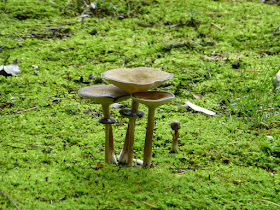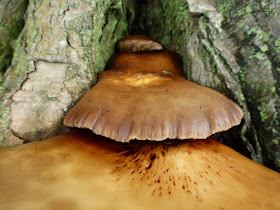Korakuen is listed as one of the three most beautiful gardens in Japan, in addition to Kenrokuen and Kairakuen. And it's definitely worthy of that distinction.
Like most Japanese gardens, it's laid out in a series of little scenes.
And again, like most gardens, there's a large central pond and a hill to use as a lookout point.
And yet again, like other Japanese landscape gardens, you'll find tea houses. But this one has a nice foot soaking pond.
Korakuen is much larger than other gardens, and it actually is its own island in the middle of a river. So the views are more expansive and the immersive effect is better.
The larger area means this garden can have large lawns and some groves. There are rice and tea fields, an archery range, and a crane aviary too.
A tea house.
There's a small shrine.
Another tea house.
The foot soaking pavilion.
Okayama Castle is the only building I remember being able to see outside the garden, and it serves as a nice background.
The garden used to be an entertaining place for the local feudal lord and his guests.
It was mostly overcast during my visit, but even without much shadow contrast, the garden is very beautiful. I wasn't able to return on my last visit, but I'd love to spend time on a sunny day getting even more great shots.
There are several museums located in the vicinity of Okayama Castle and Korakuen Garden. I didn't visit any of these, but fans of art or looking for a bit of a history lesson might find something of interest here. (I would like to check out a couple of them at some point,) This is Japan Guide's list of Okayama museums with important details.
Korakuen Garden is just across the river from Okayama Castle. Walk about 30 minutes straight east from Okayama Station, or take a 5-minute tram ride to Shiroshita, from where the garden and castle are an additional 10-15 minute walk. The closest entrance to the pedestrian bridge is the smaller south gate (seen in the first photo above) to the right, but the main gate is a short walk to the left after crossing the bridge. The Prefectural Museum is located beside the main gate.
The garden is open 7:30-18:00 from March 20 through September and 8:00-17:00 other times. Admission is 400 yen, but most people will want the combo ticket for 560 that includes Okayama Castle (not available when the castle has special exhibitions).

















































Reading this, I keep getting thrown by the fact that there's a Koishikawa Korakuen Garden in Tokyo that I know you know very well. Why are there at least two locations in Japan called "Korakuen" and what does the name mean? I know that the -koen suffix means park - is -kuen really the same thing?
ReplyDeleteIf you travel enough around Japan (or do enough reading about tourist places) you'll find that there are several places with the same name.
ReplyDeleteKoraku-en (instead of kora-kuen) means literally "a park to enjoy later" - it's a reference to a Chinese idea.
Given that many famous places in Japan came about from feudal times, and most Japanese names are fairly simple and based on common kanji, it started becoming really obvious to me how simply things are named in Japan. Higashiyama-koen literally means East Mountain Park. Ikebukuro means literally Pond Bag. Figure that one out.
Some identical names came about because they were in other independent feudal kingdoms and just like US states all seem to have a town of Athens, some repetition was bound to happen. However, some shrines and temples carry names from other temples to show their alliance - there are several Confucius Temples in China and Taiwan.
-en means garden, by the way, koen is a park. Actually, koen (公園) is literally public park, while most gardens began as private places for leaders.
(I hope this makes sense, and I hope it's accurate...)